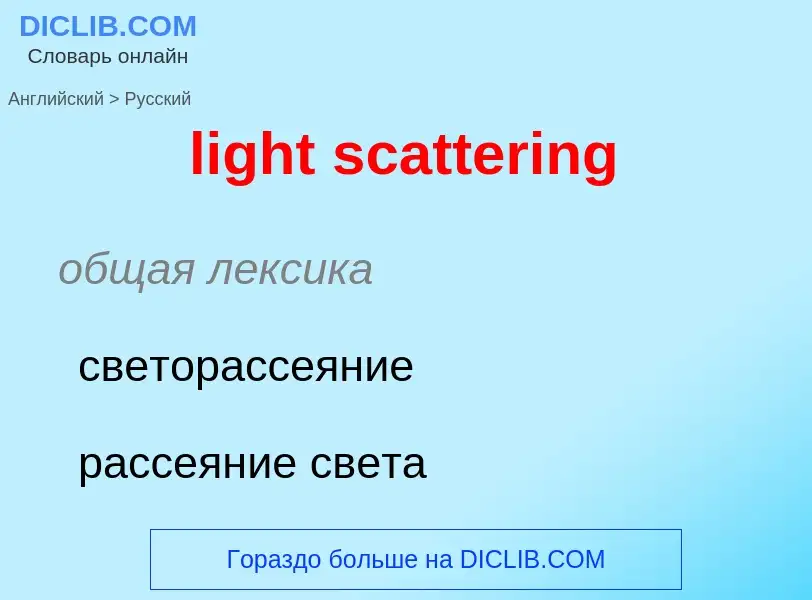Vertaling en analyse van woorden door kunstmatige intelligentie ChatGPT
Op deze pagina kunt u een gedetailleerde analyse krijgen van een woord of zin, geproduceerd met behulp van de beste kunstmatige intelligentietechnologie tot nu toe:
- hoe het woord wordt gebruikt
- gebruiksfrequentie
- het wordt vaker gebruikt in mondelinge of schriftelijke toespraken
- opties voor woordvertaling
- Gebruiksvoorbeelden (meerdere zinnen met vertaling)
- etymologie
light scattering - vertaling naar russisch
общая лексика
светорассеяние
рассеяние света
общая лексика
рассеивающий центр
Definitie
Wikipedia
Scattering is a term used in physics to describe a wide range of physical processes where moving particles or radiation of some form, such as light or sound, are forced to deviate from a straight trajectory by localized non-uniformities (including particles and radiation) in the medium through which they pass. In conventional use, this also includes deviation of reflected radiation from the angle predicted by the law of reflection. Reflections of radiation that undergo scattering are often called diffuse reflections and unscattered reflections are called specular (mirror-like) reflections. Originally, the term was confined to light scattering (going back at least as far as Isaac Newton in the 17th century). As more "ray"-like phenomena were discovered, the idea of scattering was extended to them, so that William Herschel could refer to the scattering of "heat rays" (not then recognized as electromagnetic in nature) in 1800. John Tyndall, a pioneer in light scattering research, noted the connection between light scattering and acoustic scattering in the 1870s. Near the end of the 19th century, the scattering of cathode rays (electron beams) and X-rays was observed and discussed. With the discovery of subatomic particles (e.g. Ernest Rutherford in 1911) and the development of quantum theory in the 20th century, the sense of the term became broader as it was recognized that the same mathematical frameworks used in light scattering could be applied to many other phenomena.
Scattering can refer to the consequences of particle-particle collisions between molecules, atoms, electrons, photons and other particles. Examples include: cosmic ray scattering in the Earth's upper atmosphere; particle collisions inside particle accelerators; electron scattering by gas atoms in fluorescent lamps; and neutron scattering inside nuclear reactors.
The types of non-uniformities which can cause scattering, sometimes known as scatterers or scattering centers, are too numerous to list, but a small sample includes particles, bubbles, droplets, density fluctuations in fluids, crystallites in polycrystalline solids, defects in monocrystalline solids, surface roughness, cells in organisms, and textile fibers in clothing. The effects of such features on the path of almost any type of propagating wave or moving particle can be described in the framework of scattering theory.
Some areas where scattering and scattering theory are significant include radar sensing, medical ultrasound, semiconductor wafer inspection, polymerization process monitoring, acoustic tiling, free-space communications and computer-generated imagery. Particle-particle scattering theory is important in areas such as particle physics, atomic, molecular, and optical physics, nuclear physics and astrophysics. In Particle Physics the quantum interaction and scattering of fundamental particles is described by the Scattering Matrix or S-Matrix, introduced and developed by John Archibald Wheeler and Werner Heisenberg.
Scattering is quantified using many different concepts, including scattering cross section (σ), attenuation coefficients, the bidirectional scattering distribution function (BSDF), S-matrices, and mean free path.


